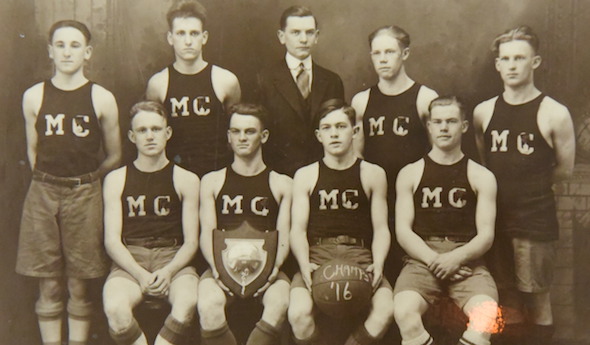
Michigan HS Hoops Celebrate a Century
February 27, 2016
By Ron Pesch
Special for Second Half
Today we know the campus, and the buildings and playing fields it contains, as Eastern Michigan University. But 100 years ago, the grounds were known as Michigan State Normal College.
On an unusually warm 2016 February day, down on the court of Eastern’s Convocation Center, the Eagles of Eastern and the University of Toledo Rockets warmed up for tip-off. Standing near the doorway of a suite, above the action, Chris Ming, athletic director at Marine City High School, showed off an oak plaque, adorned with a beautiful silver shield featuring a basketball design in relief.
“I can tell you, they don’t make them like this anymore,” Ming said.
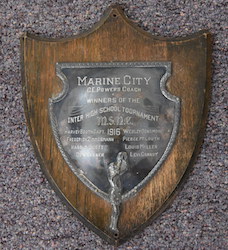 At halftime, Ming and five other representatives from Michigan high schools met at center court to celebrate an event that had occurred a century ago on this campus. In March 1916, around 100 students total representing 12 high schools traveled to Ypsilanti to participate in what has been billed as the first organized high school basketball tournament in Michigan.
At halftime, Ming and five other representatives from Michigan high schools met at center court to celebrate an event that had occurred a century ago on this campus. In March 1916, around 100 students total representing 12 high schools traveled to Ypsilanti to participate in what has been billed as the first organized high school basketball tournament in Michigan.
Historically speaking, the college was a perfect location for that tournament.
“In 1894 the Michigan State Normal College in Ypsilanti had started a new major in physical education. (Professor) Wilber Bowen was appointed chairman of that program,” wrote Dr. Erik (Rick) Pedersen, Professor Emeritus from EMU’s School of Health Promotion & Human Performance in a 2006 article for the Ypsilanti Historical Society. “Bowen had met James Naismith (who developed the game of basketball in 1891 at Springfield College in Massachusetts) through their involvement with the American Association for the Advancement of Physical Education in the late 1880's and early 1890's. To meet the needs of a new major program, the college had also completed construction of a new gymnasium in April of 1894. Bowen was looking for ideas to help with the dedication ceremony of the new gymnasium and recognition of the new major program. Consequently, arrangements were made to have the first basketball game played west of the Allegheny Mountains on May 18th, 1894, in Ypsilanti, Michigan.”
According to newspaper articles covering the 1916 high school tournament, the goal of the event was to arouse “greater interest in basketball in the smaller schools.” Around 300 invitations were sent out to high schools across the state having enrollments of “less than 200 students to take part in a basketball tournament.” It was through the efforts of the college’s Men’s Union, with cooperation from the Athletic Department, that the tournament was organized. According to the 1916 Michigan State Normal College yearbook, Aurora, the tournament also had a second goal. Acting in the best interests of the college, the Men’s Union wanted to showcase the “advantages offered at the Normal” in hopes of attracting future enrollment.
Enrollment at the time was fewer than 2,000 students. The college was the nation’s first teacher-training school to offer a four-year degree, and enrollment was dominated by females. The Men’s Union was formed in 1914 with the stated goal of bringing the male student body together socially, and to work toward recruiting more men to the college.
“Expenses related to transportation, room, and board (for the tournament) had to be provided by the participating schools,” noted Pedersen prior to the 2016 centennial gathering. “The Michigan State Normal College's Physical Education Department made it easier for schools to participate by making arrangements with local residents to provide food at 20 to 25 cents a meal and lodging at 25 cents a night for each player.”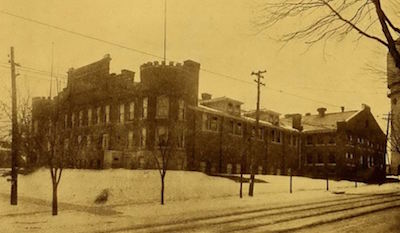 As things fell into place in Ypsilanti, awards were purchased, and prior to the contests, the trophies were placed on display at The Rowima Company, a general store near the school, to help build excitement for the games. It was also announced that players of the winning team would receive individual medals.
As things fell into place in Ypsilanti, awards were purchased, and prior to the contests, the trophies were placed on display at The Rowima Company, a general store near the school, to help build excitement for the games. It was also announced that players of the winning team would receive individual medals.
“The event is the first of its kind in the state and will be made an annual affair,” it was stated in the Daily Ypsilantian Press prior to the start of the tournament. “It is the aim to have larger high schools included in the contest if the affair is a success and as interest develops a more extensive list of prizes will be arranged. A small admission will be charged for each session which will include three or four games.”
Spread over three days, March 23 – March 25, sessions were scheduled for 7:30 on Thursday evening, 9:30 a.m., 1:30 p.m. and 7:30 p.m. on Friday, and Saturday at 9 in the morning and 1:30 in the afternoon at the Normal college gymnasium.
By Saturday afternoon, Dundee and Marine City had emerged as the tournament’s top teams, with 5-1 records, forcing a title game.
“Half the town turned out Saturday night to welcome the victorious basketball team home from Ypsilanti,” wrote a reporter for the Port Huron Times-Herald following Marine City’s thrilling 23-22 victory in the title game. “The silver shield, a trophy of the state championship, was proudly displayed by Coach Powers and every boy was glad to show his own individual (silver) medal.”
With a second-place finish, Dundee was awarded a handsome silver cup, while Milan, Mancelona and Farmington each received a banner in the Normal school colors of green and white, signifying a three-way tie in the tournament for third. Teams from East Lansing, Elkton, Middleville, Mount Clemens, Royal Oak, Saline, and Wayne also competed in the event. Teams were eliminated from play after two losses.
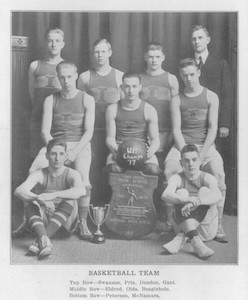 “… It was a great day for Marine City when her team won,” continued the Times-Herald article. “Each member of the high school can take credit for the victory as the money to defray the expenses of the clash was earned in a series of inter-class games played during the last two weeks.”
“… It was a great day for Marine City when her team won,” continued the Times-Herald article. “Each member of the high school can take credit for the victory as the money to defray the expenses of the clash was earned in a series of inter-class games played during the last two weeks.”
Conversations about the use of tournaments to identify a state basketball champion in Michigan had been kicked around in years past.
“As long as teams journey about the state taking on different teams, making a fairly good showing and then trying to win titles by arguments based on comparative scores, all that will result in argument and three or four champions,” stated coach Edbert C. Buss of Detroit Central High School in a 1914 article in the Jackson Citizen Patriot. “The only way I can see to settle the title on the proper team and make it undisputed is by dividing the state into three sections, an eastern, western, and northern district.”
After determining district champions, Buss suggested then a state tournament at a central location to identify a true state champion.
Teams in the Upper Peninsula of Michigan staged basketball tournaments as early as 1913, with Ishpeming claiming the U.P. crown that winter.
“Calumet claims an Upper Peninsula title for 1914,” said Robert Erkkila, a U.P. historian from the city. “We’ve never claimed it to be a state championship.” Yearbooks attest to the fact, indicating they beat Ishpeming 24-21 in the U.P. tournament hosted at the Ishpeming YMCA. “While (Notre Dame legend) George Gipp didn’t spend a lot of time in high school, and never played on Calumet’s football team, he did play basketball, and was on that team,” stated Erkkila.
In January 1917, Northern Michigan Normal College (today, Northern Michigan University) announced plans for the very first U.P. tournament, scheduled for March 2 in Marquette. Michigan State Normal College hosted their second annual tournament, beginning on March 15th, while the University of Michigan and the Michigan College of the Mines in Houghton (known these days as Michigan Tech) scheduled tournaments for the following week.
Again, 12 teams entered the Michigan State Normal College tournament, which still targeted schools with high school enrollment of 200 of fewer.
“Four games of basketball will be played at one time in the state normal gymnasium,” wrote a Flint Journal correspondent, describing Mount Morris’ planned visit to the Normal tournament. “While on this trip the boys will visit the University of Michigan and will do some sight-seeing in Detroit on the trip home.”
“The visiting teams were so well-treated and the tournament was such a success that this year not enough rooms could be found to provide for the teams, and so the offices of the Gym were turned into a veritable dormitory,” recalled the 1917 Normal annual, Aurora.
“The games were all played in quarters with a minute rest between quarters and ten minutes rest between halves,” added the Journal correspondent following the tournament. “The (Mount Morris) boys were accorded a splendid time, given free use of the swimming pool, shower baths and were treated to a banquet in the gymnasium hall by members of the faculty of the State Normal College Friday evening.”
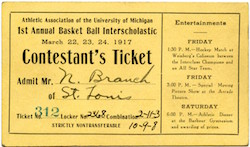 Grayling emerged as the winner of the Normal tournament, winning four games over the two-day gathering. With a 49-9 win over Chelsea, the team earned a silver cup, while team members each earned medals. With confidence, the team stayed over, rested for a few days, then entered the U-M tournament, which was open to all schools of the state.
Grayling emerged as the winner of the Normal tournament, winning four games over the two-day gathering. With a 49-9 win over Chelsea, the team earned a silver cup, while team members each earned medals. With confidence, the team stayed over, rested for a few days, then entered the U-M tournament, which was open to all schools of the state.
The interscholastic department of University of Michigan sent out around 250 printed circulars throughout the state, inviting teams to the “first annual inter-scholastic basketball tournament,” according to a January 5, 1917, article in the Flint Journal.
“Michigan’s first interscholastic basketball tournament is to be held in Waterman Gymnasium on March 22, 23 and 24, and replies from high schools of the State indicate that more than fifty quintets will battle through an elimination series for the State High school championship,” stated the February 1917 edition of The Michigan Alumnus. “This is the first time the University Athletic Association has attempted such a tournament and in view of the fact that Michigan is to have a Varsity basketball five next winter, the inauguration of the high school tourney this year becomes especially important.”
A recent enlargement of Waterman made the tournament possible. With four available courts, it was felt that the tournament could handle more than 60 teams and still be run in three days.
In total, the final field totaled 39 teams from 38 schools including squads from both peninsulas. Detroit Northwestern entered two teams, both coached by Bert Maris. The field was broken into four divisions.
“The meet is expected to result in a more satisfactory settlement of the scholastic championship than has been possible heretofore and to interest promising high school athletes in the University,” noted the March edition of the Alumnus.
The Michigan fraternities hosted the high school players during their stay with “a variety of entertainment … prepared to fill the odd hours,” including a hockey game at Weinberg Coliseum and a moving picture show at the Arcade Theater on Friday. A big dinner was planned for the final night of the tournament at the Barbour gymnasium, “at which the various cups and medals will be awarded,” according to the Alumnus. “The high school men were given the chance to get acquainted with University life and Michigan life in particular.”
“Three hundred high school players and coaches descended on the campus, and in a scene of mass confusion, 17 games were played on the first day alone,” wrote the late Dick Kishpaugh, historian for the MHSAA for 50 years. “Eventually, Detroit Northwestern, coached by Bert Maris, defeated Jackson, 24-21, to capture what virtually all observers at the time recognized as the first true state boys’ basketball champion.”
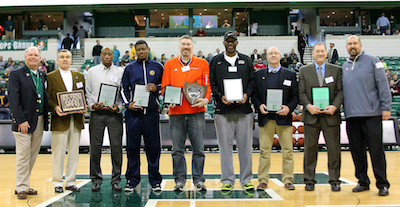 In 1918, the Michigan State Normal tournament marched on for a third year, with 16 teams participating. The title was won by Milan, with Grayling finishing second. World War I halted the University of Michigan’s plan to repeat the format of 1917. However, the desire to find a champion among the state’s larger schools saw the state’s top teams, Kalamazoo Central and Detroit Central, travel to Ann Arbor for a special one-game championship contest. The teams had split two previous meetings that year. The rubber match, and hence the title, was won by Kalamazoo 26-18.
In 1918, the Michigan State Normal tournament marched on for a third year, with 16 teams participating. The title was won by Milan, with Grayling finishing second. World War I halted the University of Michigan’s plan to repeat the format of 1917. However, the desire to find a champion among the state’s larger schools saw the state’s top teams, Kalamazoo Central and Detroit Central, travel to Ann Arbor for a special one-game championship contest. The teams had split two previous meetings that year. The rubber match, and hence the title, was won by Kalamazoo 26-18.
“Just who was in charge of the tournaments was the subject of heated debates in the early years,” Kishpaugh added. “High school administrators and the University of Michigan shared the responsibility in 1917 and 1918, but then (Michigan Agricultural College) wanted a piece of the action, and the finals were moved to East Lansing in 1919.”
That year, competition was divided into two, Class A for the larger schools and Class B for the smaller ones, setting a precedent for class competition which has been the hallmark of Michigan tournaments ever since.
In 1920, the predecessor to the MHSAA, a group called the Michigan Interscholastic Athletic Association, headed by high school administrators, took control of prep athletics and the tournament. Among their first actions was to split the finals between Ann Arbor and East Lansing each year. That year, Class A championship games were played at U-M in Ann Arbor, while Class B games were hosted at M.A.C. in East Lansing. Sites were reversed in 1921. The addition of Class C, segmenting the tournament further, came in 1922, and those games were played in the same city as Class B. The pattern was followed until 1926.
When the present Michigan High School Athletic Association was formed in the fall of 1924, Alden W. (Tommy) Thompson was hired on a full-time basis as State Director of the sport. Every tournament since 1925 has been under the direction of the MHSAA. In 1926, Class D was added, forming the approach taken to naming basketball champions in Michigan that we still use today.
 Ron Pesch has taken an active role in researching the history of MHSAA events since 1985 and began writing for MHSAA Finals programs in 1986, adding additional features and "flashbacks" in 1992. He inherited the title of MHSAA historian from the late Dick Kishpaugh following the 1993-94 school year, and resides in Muskegon. Contact him at [email protected] with ideas for historical articles.
Ron Pesch has taken an active role in researching the history of MHSAA events since 1985 and began writing for MHSAA Finals programs in 1986, adding additional features and "flashbacks" in 1992. He inherited the title of MHSAA historian from the late Dick Kishpaugh following the 1993-94 school year, and resides in Muskegon. Contact him at [email protected] with ideas for historical articles.
PHOTOS: (1) The Marine City boys basketball team won the inaugural high school basketball tournament at Michigan State Normal College. (2) A plaque commemorating the achievement hangs at the school. (3) The gymnasium at what is now Eastern Michigan University hosted the event. (4) Ishpeming won the first basketball tournament played in the Upper Peninsula. (5) University of Michigan hosted a tournament for schools of all enrollments in 1917. (6) Representatives of schools that played in the 1916 tournament at Michigan State Normal College receive plaques during a game this season at EMU. (Top five photos collected by Ron Pesch; bottom photo by Jonathan Knight.)
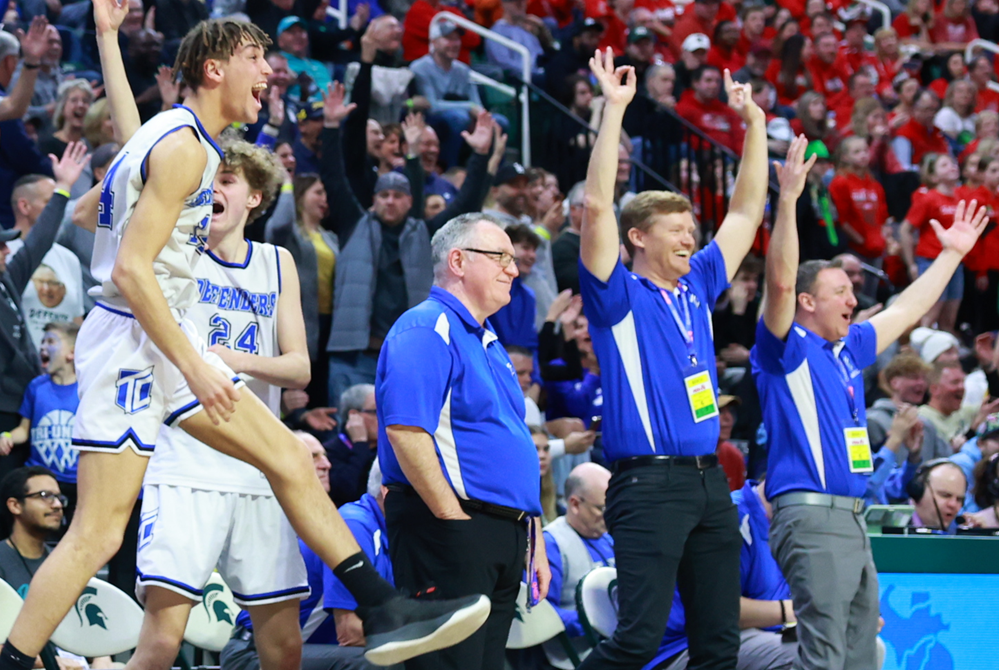
Championship Experience from Coach's Point of View Unimaginable, Unforgettable
By
Dean Holzwarth
Special for MHSAA.com
April 4, 2024
WYOMING – As the final buzzer sounded, it was all I could’ve imagined – and more.

In the weeks leading up to March 16 and the Division 4 championship game, I experienced every emotion possible as I envisioned what it would feel like to be an assistant coach on the bench at Michigan State’s Breslin Center as the Wyoming Tri-unity Christian boys basketball team achieved its ultimate goal.
In my first year as the junior varsity coach at Tri-unity, I had been on the varsity bench for a majority of the season, assisting legendary coach Mark Keeler and fellow assistants Brent Voorhees, Bob Przybysz and Mike Kaman.
I was there encouraging, motivating and supporting the varsity team. It was a role I embraced, and had become accustomed to over my almost 30 years coaching high school basketball.
I started coaching in 1995 as Jim Ringold gave me my first opportunity as the freshmen girls coach at Wyoming Kelloggsville High School. I would then coach Kelloggsville’s freshmen boys team for eight seasons, while also coaching the freshmen girls at Grandville High School. I would also coach the junior varsity teams at both schools.
I love coaching. I have a passion for it. I’ve always enjoyed getting the most out of my players while creating a bond between player and coach.
When girls basketball season moved from fall to winter joining the boys in 2007-08, I stayed at Grandville. I spent 21 seasons there before stepping down.
I still wanted to coach, and I heard that the Tri-unity junior varsity position was available. I had always respected and liked Keeler and was excited for the prospect of joining a perennial powerhouse.
I didn’t really know about Tri-unity growing up in the Wyoming Park school district. But as a young kid, I would rush home and eagerly await the afternoon delivery of the Grand Rapids Press. I would quickly find the sports page and read it from front to back, hoping one day to see my byline.
I began writing for the Press’ sports department in 1997. It was my dream job. And that’s also when I first started covering Tri-unity boys basketball.
I remember watching eventual NBA all-star Chris Kaman, along with Bryan Foltice and others play for this little Christian school and have unbridled success under Keeler.
MHSAA Tournament runs became the norm for the Defenders. They won their first Finals title in 1996, and they would claim four more over the next 26 years. They also had six runner-up finishes.
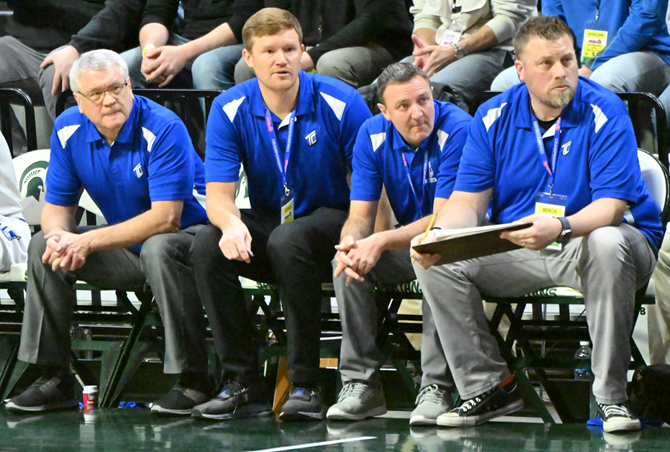 I was sitting on media row writing for MHSAA.com in 2022 when Brady Titus led Tri-unity to its fifth state championship.
I was sitting on media row writing for MHSAA.com in 2022 when Brady Titus led Tri-unity to its fifth state championship.
I never thought that two years later I would be on the coaching staff as the Defenders pursued another one. But there I was.
I knew this year’s team had the potential to be special.
Tri-unity had returned four of its five starters from a year ago, after suffering a heart-breaking two-point loss to Munising in the Division 4 Final.
Eight seniors were on the roster. The team had a mix of talented guard play, senior leadership, size and depth. We had shooters and we played great defense, a trademark of Keeler’s teams.
This was the year, and that heaped lofty expectations on Keeler and the team. It was basically “state championship or bust.” Anything less would be considered a disappointment.
Keeler wanted it badly, and I knew the players did as well. I think they felt the pressure at times of living up to the expectations that had been set.
We had several lopsided wins, but also had a few tough losses to Division 2 and Division 3 teams – Grand Rapids Forest Hills Central, Wyoming Lee, Grandville Covenant Christian and Schoolcraft – all talented teams that I think made us better despite falling short.
As the postseason started, there was anxiety and excitement.
We were one of the favorites, but it wouldn’t be easy. We would have to earn each of the seven victories needed to win it all.
First came a District title, but then we had to play a quality Fowler team in its home gym in the Regional Semifinal. This was a game we knew would be a challenge – and it was.
We led by only one at halftime after a 7-0 run to end the second quarter. The score was tied 33-33 in the fourth quarter before senior Lincoln Eerdmans made a key 3-pointer to spark our victory.
As we went through the handshake line, several Fowler players said, “Good luck in the Finals.”
Our defense played extremely well in the Regional Final and state Quarterfinal to secure our team another trip to the Breslin.
St. Ignace was our opponent in the Semifinal, and we had to face a senior guard who could do it all – Jonny Ingalls. He lived up to the hype. He was good, and we didn’t have any answer for him in the first half. We trailed by one, only to fall behind by seven late in the third quarter.
Was this the end? Were we going to fall one game short of our goal?
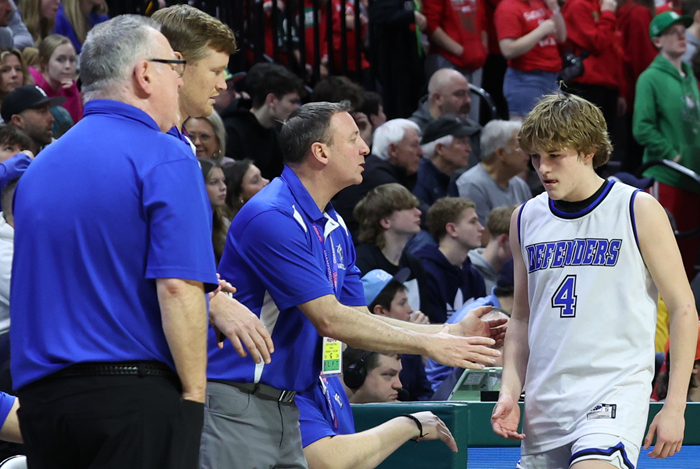 We were down by five points in the fourth quarter, but junior guard Keaton Blanker, and others, rose to the occasion. We rallied to win a tight one, and now we were one win away from a Division 4 title.
We were down by five points in the fourth quarter, but junior guard Keaton Blanker, and others, rose to the occasion. We rallied to win a tight one, and now we were one win away from a Division 4 title.
The night before the championship game, we stayed at a hotel in East Lansing as we had the first game of the day at 10 a.m. We had a team dinner, and the players seemed relaxed and eager to close out the season the way they had intended.
There was one thing that worried me. We were playing Mount Pleasant Sacred Heart. A team we had played in the second game of the season and defeated by 30 points.
Would we be overconfident? I had no idea. They were a different team now, but so were we. Anything could happen.
Keeler gave a spirited and emotional pregame speech. In last year’s loss to Munising, he felt like the team played not to lose, and this season his big thing was “I want to win.” He said it to every starter that Saturday morning during the final moments in the locker room before tipoff, asking all five individually to say it back – which they did, the first one quietly but followed by teammates replying louder and louder as everyone got fired up and “I want to win” rang through the locker room. I think it inspired all of us.
After a competitive first quarter, we started to find our rhythm and expanded the lead. We were ahead by double-digits at the half, and a state title was within our grasp. Senior Wesley Kaman buried a 3-pointer in the final seconds of the third quarter to give us a 20-point cushion. It was at that point I knew we were going to win.
All five starters reached double-figure scoring, led by Jordan VanKlompenberg with 19 points and Owen Rosendall with 14. That balance was intentional and a successful sign for our team all season.
The exhilaration of winning was intoxicating. I loved watching the boys celebrate something they had worked so hard to accomplish. I will never forget their faces. I looked to my right from my seat on the bench and watched them running onto the court, just wearing their joy. They were just elated.
I was so happy for Keeler, a devout Christian who is respected by so many people in high school basketball circles. I learned so much from him this season. The way he approaches each game, his competitiveness. He instills his strong faith in his players and understands that the game of basketball is a bridge to a higher purpose.
Keeler is the fourth-winningest coach in state boys basketball history with a record of 694-216, and will be the winningest active coach next winter as all-time leader Roy Johnston retired from Beaverton at the end of this season.
The tournament run was one of the best coaching experiences I have had, and I feel blessed to have had the opportunity to be a part of a state championship season.
 Dean Holzwarth has covered primarily high school sports for Grand Rapids-based WOOD-TV for five years after serving at the Grand Rapids Press and MLive for 16 years along with shorter stints at the Ionia Sentinel and WZZM. Contact him at [email protected] with story ideas for Allegan, Kent and Ottawa counties.
Dean Holzwarth has covered primarily high school sports for Grand Rapids-based WOOD-TV for five years after serving at the Grand Rapids Press and MLive for 16 years along with shorter stints at the Ionia Sentinel and WZZM. Contact him at [email protected] with story ideas for Allegan, Kent and Ottawa counties.
PHOTOS (Top) The Wyoming Tri-unity Christian bench, including the author (far right) and head coach Mark Keeler (middle), celebrate a 3-pointer late in the Defenders’ Division 4 championship win over Mount Pleasant Sacred Heart. (Middle) Tri-unity’s assistant coaches, including Holzwarth (second from right), monitor the action. (Below) Holzwarth and the coaching staff greet Keaton Blanker (4) as he comes off the floor. (Photos by Hockey Weekly Action Photos.)

